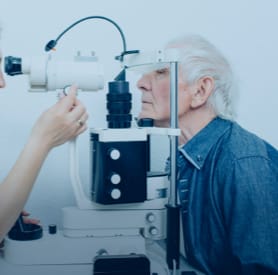Take Action Against Eye Disease
Almost 10% of Americans have eye diseases that put them at risk for severe, irreversible vision loss. Fortunately, an eye doctor can often treat or manage these problems before they get to that point.
Our eye exams at Total Vision Pleasanton, formerly Foothill Optometric Group, are designed to detect early signs of eye disease. Our goal is to catch problems in their early stages so we can recommend appropriate strategies for dealing with them. Trust us to identify your needs and help preserve your vision by scheduling an appointment today.
Common Eye Diseases
Cataracts
Cataracts appear when proteins in the lens of your eye group together, creating cloudy areas that obscure vision. Cataracts generally begin developing around age 40, but they can appear sooner in people with specific risk factors, like diabetes.
We often refer patients with cataracts to an ophthalmologist who can perform cataract surgery to restore their vision.
Glaucoma
Glaucoma is a group of eye diseases that damage the optic nerve, often when pressure rises inside the eye. Glaucoma is one of the world’s most common causes of permanent blindness.
Many cases of glaucoma progress gradually and show no symptoms until some vision loss has occurred. However, glaucoma can also appear as an acute eye emergency. In either type of case, an eye doctor’s help can be critical for preventing glaucoma’s most severe effects.
Age-related macular degeneration (AMD) is one of the most common causes of vision loss in people older than 50. AMD occurs when the macula, a part of your retina responsible for central vision, deteriorates. As a result, you might struggle to see things in the middle of your visual field and experience difficulty with everyday tasks like reading and driving.
Conjunctivitis
Many people call conjunctivitis “pink eye.” This inflammation of the blood vessels in the membrane covering the whites of your eyes often turns your eyes pink or red.
There are several types of conjunctivitis:
- Viral conjunctivitis:
- May increase your sensitivity to light.
- May create green or yellow discharge in your eyes.
- Is often transmitted by the same viruses that spread the common cold.
- Allergic conjunctivitis:
- May cause cold-like symptoms.
- May cause your eyes to water, itch, or burn.
- Is non-contagious and often caused by contact with allergens (like mold spores, pollen, or dust).
- Bacterial conjunctivitis:
- May cause green or yellow eye discharge, which can coagulate during sleep and glue your eyes together in the morning.
- Is spread by bacteria, making it highly contagious.
- Chemical conjunctivitis:
- May pose a severe and urgent risk to your eye health and vision.
- Is caused by eye contact with chemicals (including toxic liquids, fumes, and smoke), making it non-contagious.
- Requires an eye doctor’s assistance as soon as possible to prevent potential vision loss.
Diabetic Eye Disease
Over the next 3 decades, diabetic eye diseases such as diabetic retinopathy or diabetic macular edema are predicted to affect over 15 million people throughout the United States. Diabetes also increases your risk of developing cataracts and glaucoma.


Your Allies in the Fight Against Eye Disease
Our eye exams are designed to find signs of eye diseases before they become significant threats to your vision. Our eye care team is equipped to treat and manage a wide range of eye diseases once diagnosed. Contact our practice now and find the help you need.
Come See What We’re All About

Our Practice in Pleasanton
You can find us at the corner of Stoneridge Drive and Franklin Drive in picturesque Pleasanton, California.
Our Address
- 6155 Stoneridge Drive, Suite #100
- Pleasanton, CA 94588
Contact Information
- Phone: 925-463-2150
- Email: [email protected]
Hours of Operation
- Monday: 8:00 AM – 5:00 PM
- Tuesday: 8:00 AM – 5:00 PM
- Wednesday: 8:00 AM – 5:00 PM
- Thursday: 8:00 AM – 6:30 PM
- Friday: 8:00 AM – 5:00 PM
- Saturday: 8:00 AM – 2:30 PM
- Sunday: Closed
Our Brands




Our Google Reviews
Be the First to Know,
Be the First to Win.
From eye health insights to exclusive giveaways, your feed just got a lot clearer.







